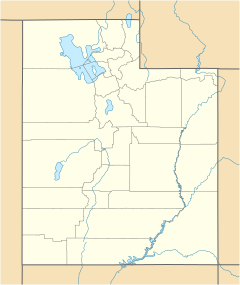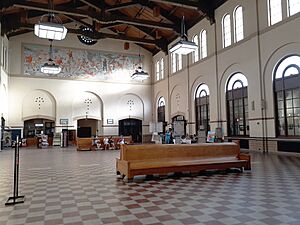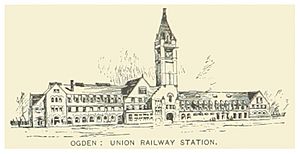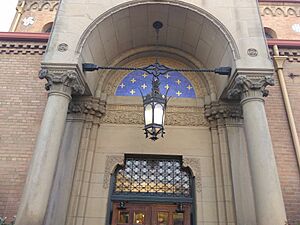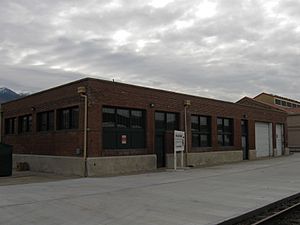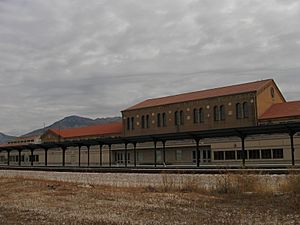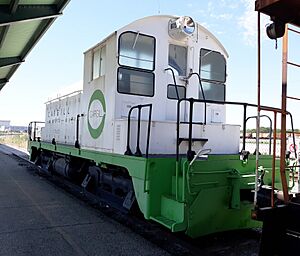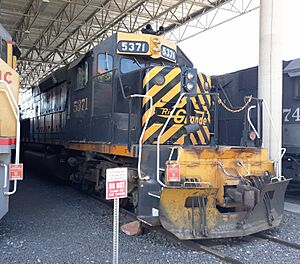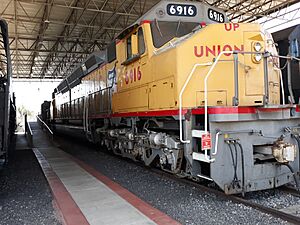Union Station (Ogden, Utah) facts for kids
Quick facts for kids
Ogden Union Station
|
||
|---|---|---|
| Former Union Pacific Railroad, Southern Pacific Railroad, Denver and Rio Grande Western Railroad, and Amtrak station | ||
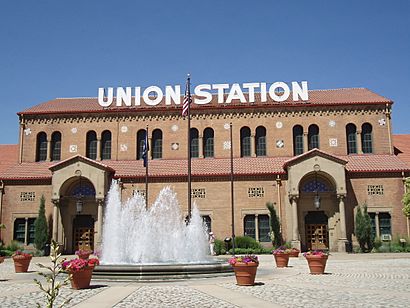
Station building, reconstructed in 1924 after the fire, June 2008
|
||
| Location | 2501 South Wall Avenue Ogden, Utah United States |
|
| Coordinates | 41°13′15″N 111°58′47″W / 41.22083°N 111.97972°W | |
| Owned by | City of Ogden | |
| Operated by | Amtrak (former) Ogden Union Railway & Depot Co. (former) | |
| Line(s) | Multiple | |
| Platforms | 1 island and 1 side platform | |
| Tracks | Utah State Railroad Museum | |
| Construction | ||
| Parking | Yes | |
| Other information | ||
| Status | Railway Museum and Community Center | |
| Station code | OGD | |
| History | ||
| Opened | 1869 | |
| Closed | May 1997 | |
| Rebuilt | 1889 and 1924 | |
| Former services | ||
| Lua error in Module:Adjacent_stations at line 236: Unknown line "Butte-Salt Lake City".
|
||
|
Ogden Union Depot
|
||
| Built | 1924 | |
| Architect | John Parkinson and Donald B. Parkinson | |
| Architectural style | Spanish Colonial Revival | |
| NRHP reference No. | 71000867 05000363 (boundary increase) |
|
| Added to NRHP | April 11, 1971 | |
| Location | ||
Union Station, also known as Ogden Union Station, is a historic train station in Ogden, Utah. It sits at the west end of Historic 25th Street. This station was once a very important meeting point for major railroads like the Union Pacific (UP) and Central Pacific. Its name, "Union Station," means that different train companies shared its tracks and buildings.
Today, Union Station is no longer a busy train hub. Instead, it's a lively cultural center. It is home to several museums, including the Utah State Railroad Museum, the Spencer S. Eccles Rail Center, the John M. Browning Firearms Museum, the Utah Cowboy and Western Heritage Museum, and the Browning-Kimball Classic Car Museum. There's also an art gallery that shows work from local artists. The Myra Powell Gallery features special exhibits and the station's own art collection. You can also find a research library with old photos and documents about Ogden.
The last long-distance passenger train to use Union Station was Amtrak's Pioneer in May 1997. A newer station, Ogden Central station, is nearby. It serves the Utah Transit Authority's (UTA) FrontRunner commuter rail line and the Ogden Express bus rapid transit line.
In December 2022, Ogden City bought the land around the station from Union Pacific for $5.5 million. The city plans to develop the area into a downtown business and tourist spot. They also hope to bring train service back to the station itself.
Contents
History of Ogden's Train Station
Becoming a "Junction City"
On March 8, 1869, the Union Pacific Railroad built tracks through Ogden. These tracks were on their way to Promontory Summit. There, they met the Central Pacific Railroad, finishing the First transcontinental railroad across the United States. This was a huge moment for the country!
Even though the famous Golden spike ceremony happened at Promontory, it was too far away to be the main meeting point for the two railroads. So, they decided to build a larger station further east. Three cities nearby wanted to be this important junction: Corinne, Uintah, and Ogden. They knew that being a major train hub would bring many travelers and businesses.
Corinne was an early favorite. However, The Church of Jesus Christ of Latter-day Saints, whose members made up most of Utah's population, didn't want a rough railroad town representing their area. In 1874, Brigham Young, the Church President, encouraged people to give or sell him land. He then gave this land to the railroads. His condition was that they build their facilities in west Ogden. This plan worked, and Ogden officially became the junction point for the transcontinental railroad.
At first, each railroad had its own station. The Union Pacific built the first permanent station in Ogden in November 1869. It was a two-story wooden building near the Weber River. After Ogden became the junction city in 1874, this building became a shared terminal. Other railroads also used it, like the Utah Central Railroad to Salt Lake City. The Utah and Northern Railway went north, and the Rio Grande Western (RGW) went south to Colorado. This quickly made Ogden a major travel center for the entire Intermountain West. Travelers from the east or west could switch trains here to reach many other places. Because of this, Ogden and Utah earned the nickname "Crossroads of the West."
Building the Union Station
The first station wasn't in a great spot for passengers. People complained about walking a long way over swampy ground to get there. So, the Union Pacific and Central Pacific railroads created a new company. It was called the Ogden Union Railway & Depot Co. (OUR&D). This company was in charge of building and running a new, shared "Union Station."
The first Union Station was finished in 1889. It was built in the Romanesque Revival style and had a large clock tower. This brick building was much bigger than the first station. It had 33 hotel rooms, a restaurant, a barbershop, and other helpful services for travelers.
In 1923, a fire started in a hotel room and destroyed the inside of the station. The walls and clock tower were left very weak. A brave telephone operator stayed in the burning building to warn people to leave. Thanks to her, no one died or was hurt in the fire. The OUR&D first planned to rebuild the station exactly as it was. But then, a stone fell from the clock tower and hit a railroad worker. He was badly hurt and died on the way to the hospital. After this accident, they decided to build a completely new station. John and Donald Parkinson, famous architects, designed the new building.
The station you see today was finished in 1924. It was built in the Spanish Colonial Revival style on the old building's foundation. It opened on November 22, 1924. One famous photo from the opening showed 13 young women pulling the first train into the station with ribbons. This photo even appeared in an Italian newspaper!
The main lobby in the center of the building has a very high ceiling, about 56 feet (17 meters) tall. Murals showing the building of the Transcontinental Railroad were painted on the north and south ends of the lobby. The second floors of the north and south wings held offices for the Southern Pacific (SP), OUR&D, and UP Telegraph Department. (The SP had bought the Central Pacific in 1885).
Ogden: The "Crossroads of the West"
By the 1920s, Ogden's Union Station was very busy. It served the Union Pacific, Southern Pacific, and the Denver and Rio Grande Western Railroad (D&RGW). Many smaller local railroads also used it. At its busiest, the station had 13 passenger tracks and platforms. It had a commissary that supplied food for long-distance trains. There was also a laundry building that washed linens for most of the Union Pacific's trains. A large United States Postal Service (USPS) building handled mail trains. More than 60 passenger trains passed through Ogden every day!
This was when Ogden truly earned its nickname, "Crossroads of the West." It was a vital part of the country's transportation system. A special plaque commissioned by the Ogden City Council showed Ogden in the center. Railroad tracks spread out from it in all directions, each named after a train company. The plaque said, "You can't get anywhere without coming to OGDEN." This was the city's slogan for a while, and the plaque is still on display today.
Train traffic reached its highest point during World War I (WWI) and World War II (WWII). Ogden and its depot became a crucial stop for soldiers and supplies moving across the country for the war. Many new businesses opened on nearby 25th Street to serve the huge number of travelers.
Changes and Saving the Station
After WWII ended in 1945, train travel started to slow down. More people began flying or driving cars. By 1950, only 20 passenger trains came through daily. The building of the Interstate Highway System in the 1960s also took traffic away from trains.
By the late 1960s, only two passenger trains came through Ogden each day. The USPS stopped its Railway post office service, ending mail trains by 1967. The OUR&D removed many passenger tracks, leaving only 5 tracks and three platforms. The Union Pacific and Southern Pacific railroads began to take back their operations from the OUR&D. The commissary building was torn down in 1969. This marked the end of Ogden as a major service point for long-distance trains. The station building was often empty, with only a few OUR&D employees working there.
On May 1, 1971, the government-funded National Railroad Passenger Corporation, called Amtrak, took over most passenger train services in the U.S. Ogden was left with only one Amtrak train in each direction daily. It became clear that Union Pacific and Southern Pacific might sell or tear down the station.
Ogden City wanted to save the building. The station had always been important to the city's economy. Plans to turn it into a museum first came up in 1969. On December 7, 1971, the Ogden City Council officially asked Union Pacific to donate the station. They wanted to turn it into a museum and convention center. Over the next few years, the city held art shows and other events in the building to show its new purpose.
Ogden City officially took ownership of the station building in 1977. They also got a 50-year lease on the land around it. Renovations began to create the planned museums. Amtrak continued to sell tickets inside the building and use it as a stop for their Pioneer trains. For a short time, Amtrak also ran its California Zephyr and Desert Wind trains through Ogden, but they stopped in 1983 due to low passenger numbers.
At the dedication ceremony in 1978, Union Pacific brought their famous UP 844 steam locomotive to the new museum. They also donated a steam derrick and a steam rotary snow plow. In 1988, Utah named Union Station the Utah State Railroad Museum. This led to many more donations from Union Pacific, creating a large collection of trains on display.
The End of Regular Train Service
In 1995, Union Pacific and Southern Pacific merged their companies. The OUR&D company was officially closed shortly after. This left Union Pacific as the only company running the remaining train facilities at the station.
On May 11, 1997, the last Amtrak Pioneer train left Union Station. The route was stopped after this date. This meant the end of all regular passenger train service at Ogden's Union Station. While special trains sometimes visit, no regular passenger trains have used the station since then.
When the Utah Transit Authority (UTA) built their FrontRunner commuter rail service in 2008, they couldn't agree on how to bring it to Union Station. So, a new commuter rail station was built just north of Union Station. This is now called Ogden Central station. There is no direct way for FrontRunner passengers to get to Union Station.
The 50-year lease on the land around the station was set to end in 2027. To avoid losing the station, Union Pacific offered to sell the land to Ogden City. In December 2022, the city agreed to buy the land for $5.5 million. Now, Ogden City fully owns both the station and the land it sits on.
The station building currently houses the Utah State Railroad Museum, the John M. Browning Firearms Museum, the Browning-Kimball Classic Car Museum, the Western Heritage and Utah Cowboy Museum, and a library. It also hosts many events, like the annual Hostlers Model Railroad Festival, weddings, and craft fairs.
Station Features
OUR&D Tribute Fountains
Inside the Grand Lobby, there are two special drinking fountains. These fountains have colorful mosaics around them. They were a favorite resting spot for Hubert Lloyd Bell, the Superintendent of the OUR&D. After he passed away in 1927, the OUR&D placed a bronze plaque with his picture above the north fountain. It says, "In Memory of Hubert Lloyd Bell SUPT. O.U.RY. AND D. Co., 1918–1927, A Just Man, A Friend Who Will Be Remembered."
Mail Terminal Annex
This building was built in 1929 for the United States Postal Service (USPS). The USPS used to have a large Railway post office (RPO) service. This building is just north of the main Union Station. In 1950, a flat-roofed addition was built on the east side to sort mail. RPO service ended in the 1960s. However, the USPS continued to use the annex for regular mail until the mid-1970s.
After the station became a museum, a new section was built to connect the station and the annex. This allows people to walk between the buildings indoors all year. Today, the Mail Terminal Annex houses the Browning-Kimball Classic Car Museum and the Browning Theatre. This theater is often rented for events like craft fairs and weddings.
Trainmen's Building
The Trainmen's Building is the northernmost building on the Union Station grounds. It was built of red brick between 1903 and 1923, before the current station building. It was first used for sorting mail until the Mail Terminal Annex was built. Then, it became a locker room for OUR&D train crews. It had lockers, a changing room, and a lunchroom.
In 2006, Ogden City added lights and an alarm system to the building, which had been empty for a while. For some time, volunteers used it to restore D&RGW 223. This is a narrow-gauge steam locomotive owned by the State of Utah. However, in 2019, disagreements arose between the volunteers, the State, and Ogden City. The city then locked out the volunteers. They said they had safety concerns about how materials were handled. The city also asked the State to transfer ownership of the locomotive to them. The State has not yet responded. They plan to move the locomotive to a new museum in Salt Lake City to finish the restoration. The locomotive is currently taken apart. Most pieces are still inside the Trainmen's Building, but the boiler is outside near the passenger platform.
Butterfly Canopy and Platforms
The passenger shelter along tracks 1 and 2 is the only one left of five original canopies. The others were taken down in 1969. This canopy was built in 1928 and is 23 feet (7 meters) wide. In 1927, when train travel was busiest, a tunnel was built under the eleven tracks. Stairways led from the tunnel to each platform. This "passenger subway" allowed people to reach all tracks from the Grand Lobby without crossing active tracks. When passenger service ended, the tunnel entrances were filled for safety. However, when the platform was repaved in 2008, part of the tunnel was uncovered. There are plans to put glass over this section so visitors can see it.
Similar canopies are used at the nearby Ogden Central station. This is a nod to Ogden's rich railroad history. The Butterfly Canopy and platforms are also used by Union Pacific's Steam Team when their steam locomotives travel through. A working water column at the north end helps service these steam engines.
Laundry Building
Laundry services at Union Station started in 1906. They were first done in the commissary building, which is now gone. Dirty sheets and clothes from sleeper and diner cars were washed during their stop in Ogden. In 1951, Union Pacific built a large brick building just for laundry. Before this, extra laundry was sent to other businesses.
This new building was meant to centralize all of Union Pacific's laundry operations and save money. It was the only laundry facility built by Union Pacific. Laundry came from all over the Union Pacific network. It even came from places like Sun Valley, Bryce Canyon National Park, and Zion National Park.
The building used the latest equipment and had 105 employees. It could process 110,000 pieces of laundry in an eight-hour shift! The laundry facility closed in 1970. It was donated to Ogden City in 1986 and is currently empty.
Railroad Museum
Spencer S. & Dolores Doré Eccles Rail Center
The Spencer S. & Dolores Doré Eccles Rail Center is where many real trains from different railroads are displayed. Most of these trains are from the Union Pacific. It is located where the old OUR&D Commissary Building used to be. Here, you can see several locomotives, passenger cars, freight cars, cabooses, and railroad maintenance equipment.
Locomotives on Display
CRGX 6751
Cargill 6751 is a General Motors (GM) Electro-Motive Corporation SW1 diesel-electric switcher locomotive. It was built in 1940 and was one of the first SW1s ever made. After several owners, it was used by Cargill in Ogden. Cargill donated it in 2010, and it arrived at the museum on May 21, 2011.
D&RGW 223
Denver & Rio Grande Western 223 is a steam locomotive built in 1881. Its restoration is currently on hold due to disagreements about the building it's in and who owns the locomotive.
D&RGW 5371
Denver & Rio Grande Western 5371 is the last GM Electro-Motive Division SD40T-2 "Tunnel Motor" to still have its original Rio Grande paint. It was retired in 2009 and moved into the Rail Center in 2010.
SP 3769
Southern Pacific 3769 is a GM Electro-Motive Division GP-9 diesel-electric switcher locomotive. It was built in 1957 and later rebuilt and renumbered to 3769.
SP 7457
Southern Pacific 7457 is the first GM Electro-Motive Division SD45 diesel-electric switcher locomotive built for the Southern Pacific railroad in 1966. It was rebuilt in 1982 and renumbered to 7457. It was donated to the Utah State Railroad Museum in 2002.
UCRY 1237
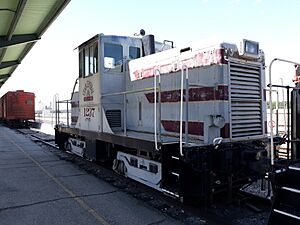
Utah Central Railway 1237 is a 44-ton General Electric diesel-electric switcher. It was originally built for the U.S. Air Force in 1953. It was donated to the museum, leased to the Utah Central Railway, and then returned to the museum.
UP 833
Union Pacific 833 is an FEF-2 class steam locomotive. It was built in 1939. It was donated to Salt Lake City in 1972 and moved to Ogden in 1999. It was the largest locomotive in the U.S. to be moved by truck!
UP 4436
Union Pacific 4436 is an 0-6-0 steam switcher built in 1918. It was donated to Ogden City in 1958 and moved to the Utah State Railroad Museum.
UP 6916
Union Pacific 6916 is a DDA40X "Centennial" diesel-electric locomotive. It was built in 1969 and is one of only 47 ever made. It was retired in 1985 and donated to the museum in 1986.
Union Pacific Rotary Snowplow 900061
This is a steam-powered rotary snowplow. It was originally built for the Oregon, Washington Railroad & Navigation Company.
UP X-26
Union Pacific X-26 is one of the Union Pacific gas turbine-electric locomotives (GTELs). General Electric built it in 1961. It was known as the "most powerful locomotive in the world." It is one of only two that still exist.
U.S. Army 1216
USAX 1216 is a 44-ton Davenport Locomotive Works switcher. It was first used at the Tooele Army Depot in Tooele, Utah.
Utah Railway #306
This is an ALCO RSD-5 locomotive that originally belonged to the Utah Railway. It was brought back to Utah in September 2022. There are plans to restore it to its original Utah Railway colors.
Utah Railway #401
A former ATSF ALCO RSD-15 built in 1959. It served on the Santa Fe railway until 1977, then on the Utah Railway. It was retired and donated to the museum in 1989.
Western Pacific #3002
Western Pacific #3002 is an EMD GP35 built in 1963. It worked for several railroads before being retired in early 2023. It was then restored to its original look and donated to the museum in May 2024.
Rolling Stock (Train Cars)
2002 Winter Olympics Cauldron Car

This special flatcar was used by Union Pacific to carry the Olympic flame for the 2002 Winter Olympics torch relay. Union Pacific donated the car to the museum after the Olympics.
U.S. Army Hospital Car
This car was one of many passenger coaches changed by the U.S. Army. They were used as hospital cars to move wounded soldiers during WWII. The museum got the car in 2001 and restored it. Since 2003, visitors can tour the inside of this historic car.
Union Pacific Golden Spike Centennial Expo Railcar
This was a passenger coach specially painted by Union Pacific. It was used as a display car to celebrate the 100th anniversary of the Golden Spike in May 1969. The car is currently on display, but its paint has faded over time.
-
UP #26, one of two surviving GE "Big Blow" 8500 Gas turbine locomotives
Future Plans for the Station
Amtrak has looked into bringing back some old train routes, including the Pioneer through Ogden. However, Ogden and the Pioneer were not part of Amtrak's "Connects US" plan for expanding train service between 2020 and 2035.
On December 8, 2022, Ogden City bought the land under and around the station from Union Pacific Railroad. This purchase, for $5.5 million, prevented the city from possibly losing the station if Union Pacific sold the land privately. As part of the purchase, Ogden City shared big plans to redevelop the area around the station. They want to turn it into a busy downtown area for businesses and tourists.
These plans include moving the current museums out of the station building. They would go into a new museum building right next door, which would also include the current Eccles Rail Center. Ogden City also wants to work with the UTA. They hope to move the FrontRunner commuter rail platforms to the station itself. This would bring train service back to the historic station. It would also allow train commuters to use the station's Grand Lobby. As of August 2025, a 180-day study is underway. This study will help Ogden City understand the costs and work needed for environmental cleanup in the station area before development can begin.
See also
- National Register of Historic Places in Weber County, Utah
- List of Amtrak stations
- List of museums in Utah


